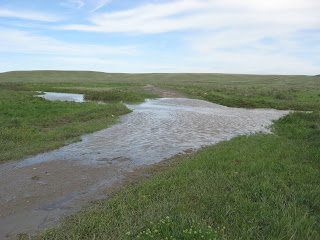Today I woke up to a beautiful day (late of course, due to the electricity's habit of turning off and on). It wasn't until my crew was ready to go that we discovered the road we take to the pastures was completely washed out due to all the rain.

There were only two nests to check in the high community pastures, which are accessible by another road. As for myself, there were 6 nests to check in the closest pasture. Since the road was off limits, I decided to just walk there. Streams that are uncrossable by ATV can sometimes be crossed by foot, if you don't mind getting a little wet. In my case, I got a LOT wet.

The prairie is more flooded than I've ever seen it. The ephemeral wetlands that have sprung up are beautiful in their own way, though I'm glad none of the nests were drowned in them. The downside, however, is the army of mosquitoes that seem to have hatched overnight.

On my walk, I travelled through a section of the community pastures I've never been through before. It was clear the ground had once been plowed for some crop or other. It was a sad sight, as the entire area had been over-run with crested wheatgrass, which is invasive. The original prairie flora had not re-colonized the area, and it was a somber reminder that this monoculture is all that may remain of native prairies if invasives are allowed to over-run.

I was pleased to find that one of the Horned Lark nests now has three fuzzy nestlings in it. These chicks are probably 2-3 days old, since their eyes are already partly open and they are able to beg for food. The dark spots inside the mouth are characteristic of Horned Lark chicks. Though you can't tell, there are actually 3 chicks in this nest.

Once the chicks hatch, the parents will remove the eggshell fragments and deposit them far from the nest. The less evidence, the less chance a predator will find the nest. Occasionally I'll find these eggshell bits lying amongst the rocks and biocrust of the prairie. This one likely came from a sparrow nest.

The sky was absolutely beautiful today. The wispy clouds were making fantastic shapes, unmarred by buildings, jet trails, and other signs of human habitation. Saskatchewan is nicknamed the "Land of Living Skies," and the title is very fitting. In fact, Grasslands National Park was recently named one of the top Dark Sky Preserves in Canada, due to its magnificent night skies.
Tomorrow is supposed to rain again, so not much hope of getting out. Even if the weather stays nice, it'll take a couple of hot sunny days to dry up the streams enough for us to take the vehicles anywhere.


Nice! I took so many sky pictures while I was there. Can't believe the flooded-out road, though... I'm glad you didn't try to take a quad through there. :)
ReplyDeleteI didn't make it out to where you were on this trip, but there is still some summer left! I had the most scenic drive into Val Marie, with a towering cumulonimbus ahead and the sun setting behind....ahhh
ReplyDeleteThis is shaping up to be like my first summer down there (2007), it rained for almost all of May and June which made the entire place Europe-like green and had a nice hot summer following. Let's hope you see something like that, but with less flooded out roads!
Sorry I didn't make it to Lockhart's on this trip, but next time (August)!